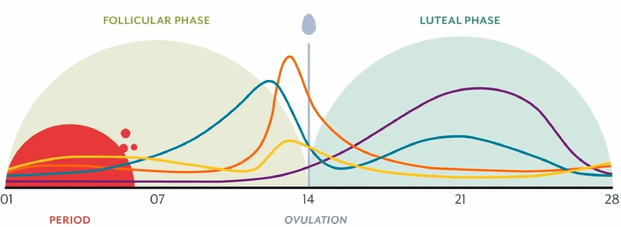Your menstrual cycle is much more than just “that time of the month.” It’s a complex process driven by shifting hormones, each influencing your energy, mood, appetite, sleep, and even how your body uses fuel. Understanding what’s happening inside your body across the month is empowering: it helps you make sense of symptoms and gives you the tools to support yourself with evidence-based nutrition and lifestyle strategies.
The Four Phases of the Menstrual Cycle
Although every woman’s cycle is unique, the typical cycle is around 28 days, divided into four phases: menstrual, follicular, ovulatory, and luteal. Here’s what happens in each, and how hormone fluctuations can affect you.
Menstrual Phase (Days 1–5)
This is when bleeding occurs. Levels of estrogen and progesterone are at their lowest, which triggers the shedding of the uterine lining. Many women experience cramps, fatigue, lower mood, and a greater need for rest. Research shows that inflammation markers are higher during this phase, which may contribute to pain and fatigue (Iacovides et al., 2015).
Follicular Phase (Days 6–13)
After menstruation, the brain signals the ovaries to prepare follicles (tiny sacs containing eggs). Estrogen begins to rise, supporting endometrial regrowth and stimulating the production of luteinising hormone (LH) in preparation for ovulation. Rising estrogen is associated with increased energy, improved mood, and enhanced insulin sensitivity (Yeung et al., 2010). Women often feel more motivated and sociable at this stage, with better tolerance for higher-intensity exercise.
Ovulatory Phase (Day 14 in a 28-Day Cycle)
A surge in LH triggers ovulation: the release of an egg. Estrogen peaks here, and progesterone starts to rise slightly. High estrogen is linked to improved verbal and social skills, but some women also report mid-cycle discomfort, known as mittelschmerz. Research indicates estrogen may enhance strength and power performance around ovulation, although findings are mixed (McNulty et al., 2020).
Luteal Phase (Days 15–28)
After ovulation, the follicle transforms into the corpus luteum, which produces progesterone. This hormone prepares the uterus for possible implantation and has a calming, sedative effect. In the early luteal phase, estrogen and progesterone are both elevated, but in the late luteal phase, both drop if pregnancy does not occur. This withdrawal is associated with PMS symptoms like irritability, bloating, cravings, breast tenderness, and low mood. Studies confirm that progesterone influences thermoregulation, raising body temperature by around 0.3–0.5°C, which can affect sleep quality and exercise tolerance (Baker & Driver, 2007).
How Hormones Influence Your Body and Mind
Mood and mental health: Estrogen supports serotonin and dopamine pathways, contributing to better mood during the follicular and ovulatory phases. Low estrogen in the late luteal and menstrual phases is linked to mood dips and irritability (Schiller et al., 2016).
Energy and exercise: Rising estrogen in the follicular phase supports energy and endurance, while progesterone dominance in the luteal phase can make you feel slower, warmer, and less resilient to intense exercise.
Appetite and cravings: Studies show women consume more calories, especially from carbohydrates and fat, in the luteal phase compared to the follicular phase (Martínez-Cordero et al., 2015). This is thought to be driven by hormonal effects on appetite regulation.
Sleep: Progesterone has sedative effects, but the temperature rise in the luteal phase can reduce sleep efficiency, especially in women with PMS (Shechter & Boivin, 2010).
Why This Matters
Understanding these patterns means you can work with your cycle, not against it. For example:
If you feel more tired and crampy during your period, it’s not weakness — it’s biology. This is a good time for gentler exercise and prioritising iron-rich foods.
If you’re full of energy in the follicular phase, you might use that to push harder in workouts or social events.
If cravings peak in the luteal phase, you can plan satisfying, balanced meals ahead of time to reduce the risk of overeating ultra-processed snacks.
Looking ahead
Now that you understand what’s happening in each phase of your cycle and why hormones influence how you feel, you can see why nutrition is such a powerful tool. The right nutrients at the right time can ease symptoms, stabilise energy, and improve overall wellbeing. That’s what we’ll explore in Part 2: Nutrition for Period Health.
If you’d like to understand your own cycle better and learn how to apply this knowledge to your life, I invite you to book a free discovery call. We’ll discuss your symptoms, your goals, and explore how a personalised approach can help you feel more in sync with your cycle.
